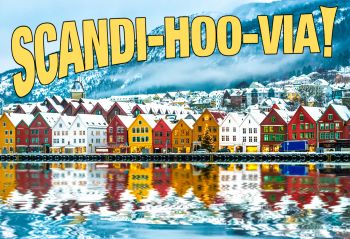Scandi-hoo-via! 5•20•18
Program
Norwegian Rhapsody, by Clare Grundman
Clare Grundman (1913–1996) was born in Cleveland and went on to study at The Ohio State University, earning bachelor’s and master’s degrees. Grundman left Ohio State in 1940 and moved to New York; he studied composition with Paul Hindemith at the Berkshire Music Center. During World War II, Grundman served for three years as Chief Musician in the U.S. Coast Guard Band. After the war, he focused on composition and wrote across many genres. He took particular interest in writing music for school ensembles of all ability levels, and he is one of the most often performed composers of band music. Many of his works are based on folk songs, including traditional melodies from England, Finland, Ireland, Japan, and Scotland. “Norwegian Rhapsody,” published in 1979, is based on six traditional Norse folk songs.
Concerto in B-flat Major, K191, by Wolfgang Amadeus Mozart (arr. Richard Fote)Mvmt. III: Rondo
W. A. Mozart (1756–1791) was just 18 when he wrote this concerto for bassoon, and it was his first concerto for a wind instrument. The piece may have been commissioned by an Austrian aristocrat who was an amateur bassoon player and already owned 74 of the young composer’s works. The original autographed score has been lost, but the completion date of the piece is known to be June 4, 1774. At that time, Mozart was employed as a court musician by the ruler of Salzburg, and he wrote works for a range of ensembles and solo instruments. Some scholars believe that Mozart wrote five bassoon concertos but that only this one survived; it is a standard in the bassoon repertoire. The third movement, “Rondo,” features a musical form with a recurring leading theme and is typical of the final movement of a sonata or concerto.
Duncan Henry, Bassoon | Winner of the 2018 Earl C. Benson Concerto Competition
Funeral March, by Edvard Grieg (arr. Jan Eriksen; ed. Frederick Fennell)
Edvard Grieg (1843–1907), Norway’s foremost composer, was born in Bergen. At age 6, he began studying piano with his mother, and at age 15, he entered the Leipzig Conservatory, then considered the most progressive music institution in Europe. At age 20, he moved to Copenhagen, where his musical development continued under the strong influence of fellow Norwegian Rikard Nordraak (1842–1866), composer of the Norwegian national anthem. During the mid-1800s, Norwegians were struggling to establish a new national identity after hundreds of years of rule by Denmark and Sweden, and Grieg and Nordraak were both committed to promoting Norwegian composers and nationalism. Sadly, Nord-raak died from tuberculosis at age 24. Grieg wrote “Funeral March” for piano in memory of his beloved friend, and he also had the piece performed at his own funeral more than 40 years later.
Valdres Norwegian March, by Johannes Hanssen (arr. Glenn C. Bainum)
Johannes Hanssen (1874–1967) was born in Ullensaker, Norway, and had a long, celebrated career performing, conducting, and teaching in Oslo. This march, “Valdresmarsjen,” is his most famous work and honors the spectacular region of Valdres, which lies between Oslo and Bergen in south-central Norway. The main theme of the march is the fanfare of the Valdres Battalion, which is based on an ancient Norse melody; the trio section is based on a fiddle tune and folk song from Hardanger, a district in western Norway. When the march was first performed in 1904 by Norway’s Second Regiment Band, Hanssen played the baritone part himself.
Intermission
Grieg Suite, by Edvard Grieg (arr. Tom Clark)
I. Patriotic Song, Op. 12, No. 8
II. Watchman’s Song, Op. 12, No. 3
III. Grandmother’s Minuet, Op. 68, No. 2
IV. Solvejg’s Song, Op. 52, No. 4
V. Sailor’s Song, Op. 68, No. 1
Tom Clark presents five of Edvard Grieg’s most well known compositions in Grieg Suite, published in 1929. Movements I, II, III, and V are from Grieg’s Lyric Pieces, a collection of 66 short works for solo piano written and published in 10 volumes from 1867 to 1901. Grieg was considered the master of this type of short, lyrical composition, and his collection represents the full spectrum of moods and styles of Norwegian folk music. These pieces are still popular in the repertoire for pianists of all levels. Movement IV, “Solvejg’s Song,” is from Peer Gynt, a play in verse by Norwegian Henrik Ibsen for which Grieg composed incidental music; this version of the play premiered in 1876 in Oslo, and Grieg conducted the orchestra. Solvejg is the spurned love of the title character, the scoundrel Peer, and she sings of her enduring hope that he will someday return to her. Grieg later reorchestrated eight of the pieces composed for the play as two four-movement suites for orchestra. He also arranged some of the selections from Lyric Pieces for orchestra, producing Lyric Suite.
Wedding Day at Troldhaugen, Op. 65, No. 6, by Edvard Grieg (arr. L. P. Laurendeau)
At age 20, Edvard Grieg moved to Copenhagen—at the time, the cultural center of Scandinavia—to further his development as a composer. There, he reconnected with a first cousin, Nina Hagerup, who had been born in Bergen but lived much of her life in Denmark. The two were secretly engaged in 1864 and then married in 1867. The next year, Grieg achieved instant fame with release of his Piano Concerto in A minor, and the couple traveled extensively across Scandinavia and Europe promoting what had become known as the Norwegian School of Music. Although they returned regularly to Norway, they did not have a home there until 1885, when they built a villa in Troldhaugen, just outside Bergen. Grieg composed many of his best-known works in the garden hut on the grounds, which served as his studio. He wrote “Wedding Day at Troldhaugen” in 1896 to commemorate the twenty-fifth anniversary of his marriage to Nina, which the couple had celebrated four years earlier. It is the most well known work in Book VIII of Grieg’s collection Lyric Pieces.
Finlandia, Op. 27, No. 7, by Jean Sibelius (trans. Clark McAllister; ed. Alfred Reed)
Jean Sibelius (1865–1957), Scandinavia’s most noted symphonic composer, was born in Hämeenlinna, Finland. He attended the Finnish Normal School, the first Finnish-language school in Russian-held Finland, and studied Finnish literature and mythology. He entered college to study law but within a year had changed his course of study to music. Realizing his limited ability as a violinist, he focused on composition, and by age 32, he had established himself as Finland’s foremost composer. He wrote what would become “Finlandia” in 1899 as the finale to a set of works created for a political demonstration in support of freedom of the Finnish press, which was censored by the Russian government. Originally called “Finland Awakes,” the piece was adapted, renamed, and then performed by the Helsinki Philharmonic at the Paris World Exhibition of 1900. “Finlandia” is a tone poem, which is a single-movement composition inspired by a literary or natural sequence of events—in this case, Finland’s national awakening and fighting spirit. (Finland declared independence from Russia in 1917 following the Russian Revolution.)
“Sarabande,” from Suite Ancienne, Op. 31, by Johan Halvorsen (arr. Jerry Luckhardt)
Johan Halvorsen (1864–1935) was born in Drammen, Norway, and recognized at a young age to be an accomplished violinist. He became concertmaster of the Bergen Philharmonic at age 21. Halvorsen left Norway for several years and held positions as concertmaster and professor of music in Germany, Scotland, and Finland. In 1893, he returned to his homeland and became principal conductor of the Bergen Philharmonic and conductor of the orchestra at Den Nationale Scene (“The National Stage”), the largest theater in Bergen. In 1899, he was appointed conductor of Norway’s new National Theater Orchestra—a position he held for 30 years until retiring. During his career, Halvorsen conducted a variety of theatrical music and wrote incidental music for 30-plus plays, along with three symphonies and two Norwegian rhapsodies. The music that comprises Suite Ancienne originated as incidental music for a play by eighteenth-century Norwegian playwright Ludvig Holberg, who was a key figure in Danish and Norwegian literature. Halvorsen arranged the music for orchestra in 1911 and dedicated the suite to the playwright. Interestingly, Halvorsen was married to Edvard Grieg’s niece and orchestrated some of Grieg’s piano works, including the funeral march played at Grieg’s funeral.
Program notes by Susan Freese
Upcoming Performances
Join our mailing list
Subscribe to our email newsletter to learn about upcoming concerts.


